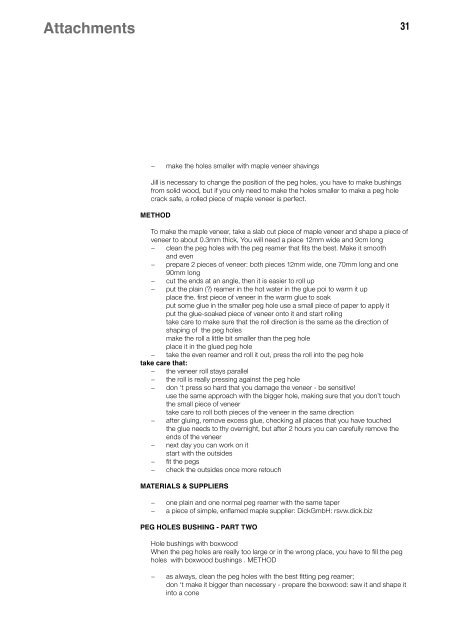advanced violin restoration techniques - International Specialised ...
advanced violin restoration techniques - International Specialised ...
advanced violin restoration techniques - International Specialised ...
Create successful ePaper yourself
Turn your PDF publications into a flip-book with our unique Google optimized e-Paper software.
Attachments<br />
− make the holes smaller with maple veneer shavings<br />
Jill is necessary to change the position of the peg holes, you have to make bushings<br />
from solid wood, but if you only need to make the holes smaller to make a peg hole<br />
crack safe, a rolled piece of maple veneer is perfect.<br />
METHOD<br />
To make the maple veneer, take a slab cut piece of maple veneer and shape a piece of<br />
veneer to about 0.3mm thick, You will need a piece 12mm wide and 9cm long<br />
− clean the peg holes with the peg reamer that fits the best. Make it smooth<br />
and even<br />
− prepare 2 pieces of veneer: both pieces 12mm wide, one 70mm long and one<br />
90mm long<br />
− cut the ends at an angle, then it is easier to roll up<br />
− put the plain (?) reamer in the hot water in the glue poi to warm it up<br />
place the. first piece of veneer in the warm glue to soak<br />
put some glue in the smaller peg hole use a small piece of paper to apply it<br />
put the glue-soaked piece of veneer onto it and start rolling<br />
take care to make sure that the roll direction is the same as the direction of<br />
shaping of the peg holes<br />
make the roll a little bit smaller than the peg hole<br />
place it in the glued peg hole<br />
− take the even reamer and roll it out, press the roll into the peg hole<br />
take care that:<br />
− the veneer roll stays parallel<br />
− the roll is really pressing against the peg hole<br />
− don ‘t press so hard that you damage the veneer - be sensitive!<br />
use the same approach with the bigger hole, making sure that you don’t touch<br />
the small piece of veneer<br />
take care to roll both pieces of the veneer in the same direction<br />
− after gluing, remove excess glue, checking all places that you have touched<br />
the glue needs to thy overnight, but after 2 hours you can carefully remove the<br />
ends of the veneer<br />
− next day you can work on it<br />
start with the outsides<br />
− fit the pegs<br />
− check the outsides once more retouch<br />
MATERIALS & SUPPLIERS<br />
− one plain and one normal peg reamer with the same taper<br />
− a piece of simple, enflamed maple supplier: DickGmbH: rsvw.dick.biz<br />
PEG HOLES BUSHING - PART TWO<br />
Hole bushings with boxwood<br />
When the peg holes are really too large or in the wrong place, you have to fill the peg<br />
holes with boxwood bushings . METHOD<br />
− as always, clean the peg holes with the best fitting peg reamer;<br />
don ‘t make it bigger than necessary - prepare the boxwood: saw it and shape it<br />
into a cone<br />
31

















